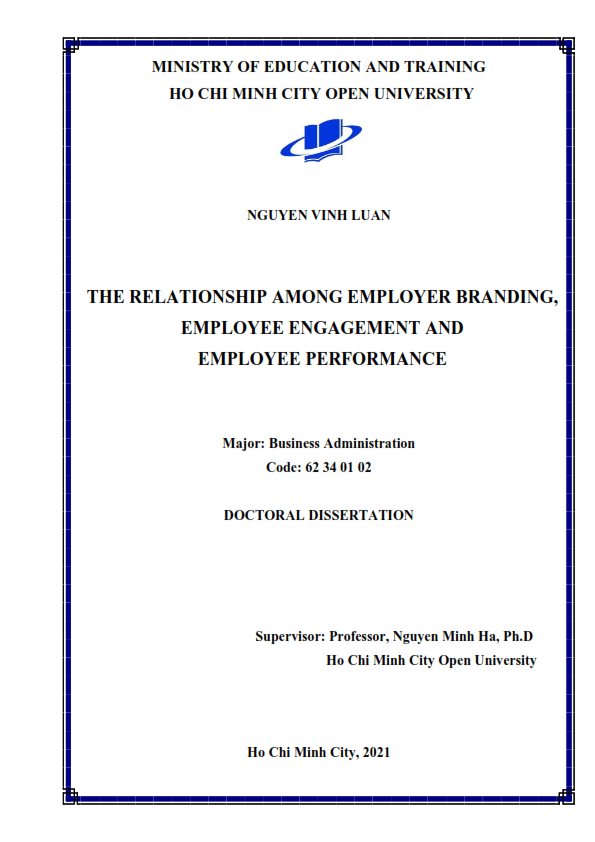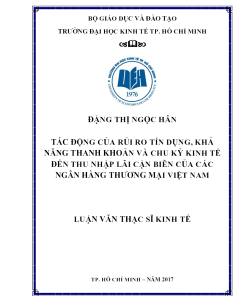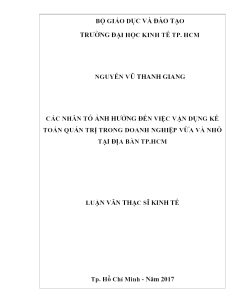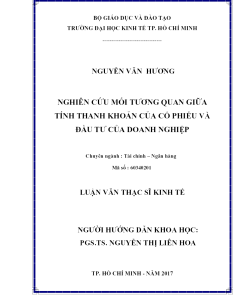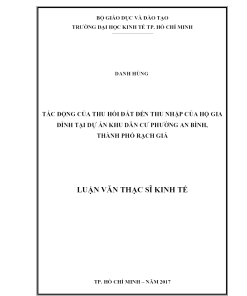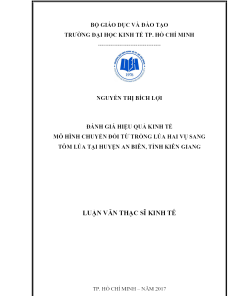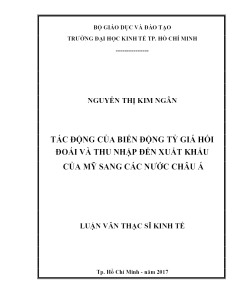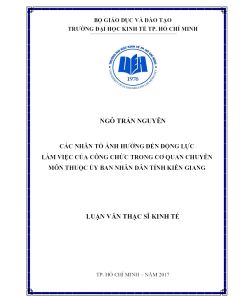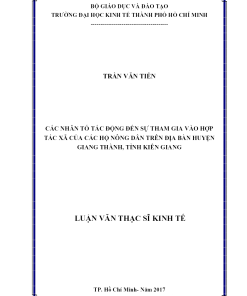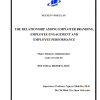- Giảm 10% phí tải tài liệu khi like và share website
- Tặng 1 bộ slide thuyết trình khi tải tài liệu
- Giảm 5% dịch vụ viết thuê luận văn thạc sĩ của Luận Văn A-Z
- Giảm 2% dịch vụ viết thuê luận án tiến sĩ của Luận Văn A-Z
The relationship among employer branding, employee engagement and employee performance
100.000 VNĐ
Dissertation title: The relationship among employer branding, employee engagement and employee performance
Dissertation title: The relationship among employer branding, employee engagement and employee performance
Download Luận án tiến sĩ: Mối quan hệ giữa thương hiệu nhà tuyển dụng, sự gắn kết của nhân viên và hiệu quả làm việc của nhân viên
1. Về mặt lý thuyết
Thứ nhất, luận án đã làm rõ khái niệm và tìm ra mối quan hệ giữa thương hiệu nhà tuyển dụng và sự thu hút nhà tuyển dụng. Đây là một khám phá rất mới và thú vị trong nghiên cứu về lý thuyết thương hiệu nhà tuyển dụng. Hai khái niệm này rất dễ gây nhầm lẫn với các nghiên cứu trước đây về mối quan hệ giữa hai yếu tố này, nghiên cứu này đã chứng minh tác động tích cực của thương hiệu nhà tuyển dụng đối với sự thu hút nhà tuyển dụng với hệ số tác động cao bằng Phương pháp SEM. Kết quả có thấy hệ số tác động 0,856 và mức ý nghĩa 99% được hỗ trợ bởi lý thuyết hành vi có kế hoạch của Ajzen (1985) và lý thuyết nhận thức xã hội (Bandura, 1977, 1986). Dựa trên lý thuyết này, thương hiệu nhà tuyển dụng sẽ thực hiện các hoạt động xây dựng các giá trị tốt đẹp của doanh nghiệp để thu hút và giữ chân người lao động. Thông qua các hoạt động này của doanh nghiệp sẽ giúp tác động tích cực và tạo cho nhân viên có nhận thức rõ ràng về những giá trị này. Tóm lại, xuất phát từ nền tảng lý thuyết vững chắc và được kiểm định bằng phương pháp SEM với số lượng mẫu lớn (937 biến quan sát), mối quan hệ giữa thương hiệu nhà tuyển dụng và sự thu hút của nhà tuyển dụng được minh họa rõ hơn, góp phần tạo đóng góp những luận cứ mới mang tính hệ thống trong lý thuyết này.
Thứ hai, luận án tìm hiểu tác động tích cực của thương hiệu nhà tuyển dụng đối với sự gắn kết của nhân viên. Bởi vì hầu hết các nghiên cứu trước đây đều tập trung vào mối quan hệ của thương hiệu nhà tuyển dụng với các ứng viên tiềm năng như sự hấp dẫn, nhận biết của các ứng viên tiềm năng, v.v. và rất ít nghiên cứu về tác động của thương hiệu nhà tuyển dụng đối với nhân viên hiện tại của công ty, nghiên cứu này nhằm khám phá mối quan hệ giữa hai yếu tố này và để mở ra một hướng nghiên cứu mới trong tương lai. Kết quả mang lại một đặc điểm mới trong lý thuyết xây dựng thương hiệu nhà tuyển dụng và đóng góp thêm cơ sở lý thuyết cho các nhà nghiên cứu sâu hơn để khám phá tác động của thương hiệu nhà tuyển dụng đối với sự gắn kết của nhân viên. Đặc biệt, thang đo thương hiệu nhà tuyển dụng bao gồm 10 khía cạnh: CSR, sự cân bằng giữa công việc và cuộc sống hoặc cơ hội du lịch.v.v… có thể mở ra nhiều hướng có thể nâng cao sự gắn kết của nhân viên trong tổ chức. Tóm lại, những phát hiện này không chỉ mở ra một hướng mới trong mối quan hệ thương hiệu nhà tuyển dụng ảnh hưởng đến nhân viên hiện tại mà còn mở rộng các yếu tố của thương hiệu nhà tuyển dụng khác nhau ảnh hưởng đến sự gắn kết của nhân viên.
Thứ ba, luận án tìm hiểu tác động tích cực của sự thu hút nhà tuyển dụng đối với sự gắn kết của nhân viên. Tương tự như yếu tố thương hiệu nhà tuyển dụng, trong các nghiên cứu trước đây, sự thu hút nhà tuyển dụng chủ yếu tập trung vào việc ảnh hưởng đến ứng viên tiềm năng và chủ yếu tập trung vào việc thu hút ứng viên bên ngoài hoặc một yếu tố duy nhất: CSR (Ferreira & Oliveira, 2014), giá trị việc làm (Heger, 2007), huấn luyện tích cực (Maceachern, 2003) .v.v…tác động đến sự gắn bó chứ không phải một sự tác động mang tính tổng thể của sự thu hút nhà tuyển dụng tác động như kết quả của nghiên cứu này. Hơn nữa, định nghĩa ban đầu về sự thu hút nhà tuyển dụng cũng tập trung vào các ứng viên tiềm năng hơn là các ứng viên nội bộ (Berthon và cộng sự., 2005). Do đó, khi phân tích và chứng minh tác động của sự thu hút nhà tuyển dụng đến sự gắn kết của nhân viên sẽ giúp mở ra một hướng nghiên cứu hoàn toàn mới và đóng góp vào hệ thống lý luận chung về sự thu hút nhà tuyển dụng. Đồng thời, kết quả này cũng bổ sung cho sự gắn kết của nhân viên một tiền tố quan trọng bên cạnh các tiền tố truyền thống. Điều này sẽ hỗ trợ cả về lý thuyết và thực tiễn cho doanh nghiệp trong việc xây dựng nhận thức của nhân viên về hình ảnh doanh nghiệp cũng như các giải pháp để giữ chân nhân tài.
Thứ tư, ngoài việc tìm ra mối quan hệ giữa sự thu hút nhà tuyển dụng và sự gắn kết của nhân viên, luận án còn phát hiện ra một điểm mới quan trọng là sự thu hút nhà tuyển dụng có tác động tích cực đến hiệu quả làm việc của nhân viên. Mặc dù yếu tố hiệu quả làm việc của nhân viên được nghiên cứu nhiều nhưng chủ yếu là do các tiền tố khác. Các nghiên cứu trước đây về tác động của sự thu hút nhà tuyển dụng đối với hiệu quả của nhân viên chủ yếu chỉ là một phần trong khái niệm này như hiệu quả hoạt động xã hội của doanh nghiệp (Backhaus và cộng sự., 2002), học tập và phát triển (Pingle & Sharma, 2013), v.v. Do đó, kết quả nghiên cứu này cho thấy tác động tổng thể và toàn diện của sự thu hút nhà tuyển dụng đến hiệu quả làm việc của nhân viên. Từ đó mở ra một hướng mới cho các nhà nghiên cứu về mối quan hệ giữa hai yếu tố này cũng như bổ sung vào hệ thống lý thuyết về thương hiệu nhà tuyển dụng liên quan đến yếu tố sự thu hút nhà tuyển dụng.
Thứ năm, luận án đã xây dựng thang đo thương hiệu nhà tuyển dụng mới trên cơ sở tích hợp các thang đo trước đó của các tác giả Tanwar & Prasad (2017), Chauhan & Mahajan (2013), Lievens (2007), Lorys (2017), Carlson và cộng sự (2000) thông qua nghiên cứu định tính. Đặc biệt, thang đo thương hiệu nhà tuyển dụng đã bổ sung rất nhiều nhân tố liên quan đến cân bằng công việc và cuộc sống. Cụ thể, các yếu tố liên quan đến nội dung này chiếm 4/6 yếu tố trong thang đo này bao gồm: Sự hài lòng cân bằng giữa công việc và cuộc sống (WLSA), Sự can thiệp của gia đình dựa trên hành vi đối với công việc (WLBE), Sự can thiệp của công việc dựa trên thời gian với gia đình (WLTI) và Sự can thiệp của gia đình dựa trên mức độ căng thẳng với công việc (WLST). Những yếu tố này rất toàn diện cho sự cân bằng giữa công việc và cuộc sống (sự hài lòng, cân bằng hành vi, thời gian và căng thẳng). Đây là một khám phá mới về cấu trúc của thang đo thương hiệu nhà tuyển dụng. Ngoài ra, sự kết hợp của 10 yếu tố bao gồm: Trách nhiệm xã hội của doanh nghiệp (CSR), Thăng tiến (PRO), Sự hài lòng cân bằng giữa công việc và cuộc sống (WLSA), Giáo dục (EDU), Sự can thiệp của gia đình dựa trên hành vi đối với công việc (WLBE), Cơ hội du lịch ( TRA), Sự can thiệp của công việc dựa trên thời gian với gia đình (WLTI), Làm việc theo nhóm (GRO), Hỗ trợ (SUP) và Sự can thiệp của gia đình dựa trên mức độ căng thẳng với công việc (WLST) đã tạo ra một quy mô mới cho thương hiệu nhà tuyển dụng. Thông qua các kiểm định vể độ tin cậy của thang đo, các yếu tố này được chứng minh là đủ tin cậy để đại diện cho thang đo của khái niệm này. Do đó, việc tạo ra thang đo mới này sẽ giúp bổ sung cho hệ thống khái niệm thương hiệu nhà tuyển dụng cũng như hỗ trợ các nhà nghiên cứu sau có thêm tài liệu tham khảo khi đo lường khái niệm này.
Cuối cùng, luận án xây dựng thang đo sự thu hút nhà tuyển dụng với một yếu tố mới: giá trị an toàn. Đây là yếu tố rất quan trọng đối với người lao động trong giai đoạn hiện nay khi vấn đề an toàn về thể chất và tâm lý ngày càng được quan tâm và coi trọng. Với 3 biến quan sát bao gồm: “Tổ chức tôi làm việc luôn đảm bảo an toàn lao động trong quá trình làm việc”, “Sự an toàn trong công việc luôn có trong tổ chức” và “Tổ chức tôi làm việc luôn an toàn trong môi trường làm việc (không gây áp lực, quấy rối tình dục, v.v.)”, Thang đo bao gồm tất cả các khía cạnh của giá trị an toàn trong môi trường làm việc. Qua kiểm định thang đo, giá trị an toàn hoàn toàn đáp ứng các tiêu chuẩn để trở thành một trong những nhân tố của thang đo sự thu hút nhà tuyển dụng. Xét về thực tế, thang điểm này phù hợp với xu hướng áp dụng chiến lược phát triển bền vững của các doanh nghiệp tại Việt Nam hiện nay.
2. Về mặt thực tiễn
Những phát hiện trên giúp bổ sung các yếu tố ảnh hưởng đến sự gắn kết và hiệu quả làm việc của nhân viên trong tổ chức (cân bằng giữa công việc và cuộc sống hoặc cơ hội đi du lịch và trải nghiệm, v.v.). Đồng thời, kết quả của nghiên cứu này cũng cho thấy cách thức mà doanh nghiệp có thể lập kế hoạch và thực hiện các hoạt động xây dựng thương hiệu nhà tuyển dụng để giúp tạo ra nhận thức tích cực của nhân viên hiện tại cũng như ứng viên tiềm năng.
ABSTRACT
The dissertation research on the relationship between employer branding (comprising 10 factors: Corporate social responsibility, Promotion, Work- Life Balance Satisfaction, Education, Behavior-based family interference with work, Travel opportunities, Time-based work interference with family, Teamwork, Supporting, Strain-based family interference with work), employer attractiveness (including 5 factors: social value, developmental value, application value, safety value and economic value), employee engagement (consisting of 3 factors: dedication, vigor and absorption) and employee performance (made up of 3 factors: Teamwork, Innovator and Job).
The dissertation uses a combination of qualitative and quantitative research methods (mixed method) in implementation process. Qualitative research method is used in developing interview questionnaires through direct exchanges to get expert opinions and group discussion related to built scale content, supplementing the scales is complete and appropriate to Vietnamese context. Quantitative research methods are used in the data analysis process. Quantitative analysis steps are composed of analyzing scale reliability by Cronbach’s alpha coefficient, exploratory factor analysis (EFA), SEM structural model analysis. This dissertation uses convenient sampling method (non-probability) with the participants as employees working in enterprises and organizations in Vietnam, in which the official sample size is 937 samples.
The results of testing the hypotheses in the detailed research model are as follows: a) Employer branding has a positive impact on employer attractiveness; b) Employer branding has a positive impact on employee engagement; c) Employer branding has no impact on employee performance; d) Employer attractiveness has a positive impact on employee engagement; e)
Employer attractiveness has a positive impact on employee performance; f) Employee engagement has no impact on employee performance.
Based on hypothesis testing outcomes in the research model, the dissertation discusses the results and proposes managerial implications to provide managers with measures towards the improved quality of employer branding besides employer attractiveness development so as to better employee engagement and employee performance.
Page i
CONTENT
CONTENT ……………………………………………………………………………………………………i LIST OF TABLES ……………………………………………………………………………………….v LIST OF FIGURES …………………………………………………………………………………….ix CHAPTER 1: INTRODUCTION………………………………………………………………….1
1.1 PROBLEM STATEMENTS ………………………………………………………………..1
1.1.1 Practical reasons……………………………………………………………………………..1
1.1.2 Literature review …………………………………………………………………………….4
1.1.3 From previous studies ……………………………………………………………………..6
1.1.4 Problem statements …………………………………………………………………………9
1.2 RESEARCH OBJECTIVE AND RESEARCH QUESTIONS ……………..13
1.3 RESEARCH SCOPE AND RESEARCH PARTICIPANT ………………….14
1.3.1 Research Scope …………………………………………………………………………….14
1.3.2 Research Participant………………………………………………………………………14
1.3.3 Time of survey ……………………………………………………………………………..14
1.4 NEW FINDINGS……………………………………………………………………………….14
1.5 STUDY SIGNIFICANCE…………………………………………………………………..15
1.6 THESIS STRUCTURE………………………………………………………………………17
CHAPTER 2: LITERATURE REVIEW……………………………………………………..19
2.1 CONCEPTS ………………………………………………………………………………………19
2.1.1 Employer Branding ……………………………………………………………………….19
2.1.2 Employer Attractiveness ………………………………………………………………..22
2.1.3 Employee Engagement ………………………………………………………………….24
2.1.4 Employee Performance ………………………………………………………………….25
2.2 MAIN THEORIES…………………………………………………………………………….27
2.2.1 Social exchange theory ………………………………………………………………….28
Page ii
2.2.2 Person – Organization Fit Theory ……………………………………………………36
2.2.3 Theory of Employer Branding ……………………………………………………….. 46
2.2.4 Theory of Employee Engagement…………………………………………………… 50
2.2.5 Theory of planned behavior and social cognitive theory…………………….53
2.2.6 Reviewing previous studies ……………………………………………………………58
2.2.7 The research gap …………………………………………………………………………119
2.3 RESEARCH HYPOTHESIS AND STUDY MODEL ………………………..120
2.3.1 Impact of employer branding on employer attractiveness …………………120
2.3.2 Impact of employer branding on employee engagement …………………..129
2.3.3 Impact of employer branding on employee performance ………………….133
2.3.4 Impact of employer attractiveness on employee engagement ……………136
2.3.5 Impact of employer attractiveness on employee performance …………..150
2.3.6 Impact of employee engagement on employee performance …………….163
2.4 PROPOSED RESEARCH MODEL………………………………………………….166
SUMMARY OF CHAPTER 2 …………………………………………………………………..166
CHAPTER 3: METHODOLOGY……………………………………………………………..169
3.1 RESEARCH DESIGN ……………………………………………………………………..169
3.2 SAMPLING AND DATA COLLECTION ………………………………………..171
3.2.1 Sampling ……………………………………………………………………………………171
3.2.2 Data collection ……………………………………………………………………………172
3.3 SCALE MEASUREMENTS …………………………………………………………….175
3.3.1 From literature…………………………………………………………………………….180
3.3.2 Opinions of the expert interviews and groups discussions ………………..180
3.3.3 The complete scale………………………………………………………………………186
3.3.4 Scale measurements …………………………………………………………………….189
3.4 DATA ANALYSIS TECHNIQUE…………………………………………………….207
3.4.1 Descriptive statistics…………………………………………………………………….209
3.4.2 Internal consistency reliability ………………………………………………………209
3.4.3 Convergent validity……………………………………………………………………..210
Page iii
3.4.4 Discriminant Validity…………………………………………………………….211
3.4.5 Multi-collinear assessment…………………………………………………………… 211
3.4.6 Path coefficients of the structure model ……………………………………………….. 211
3.4.7 Determination coefficient (R² value) ……………………………………………..212
3.4.8 Impact coefficient f² …………………………………………………………………….213
3.4.9 Blindfolding and predict relevance Q² ……………………………………………213
SUMMARY OF CHAPTER 3 …………………………………………………………………..214
CHAPTER 4: RESULTS ANALYSIS ……………………………………………………….216
4.1 DESCRIPTIVE STATISTICS………………………………………………………….216
4.1.1 Demographic ………………………………………………………………………………216
4.1.2 Scale descriptive………………………………………………………………………….220
4.2 SCALE VALIDITY ASSESSMENT …………………………………………………242
4.2.1 Cronbach Alpha ………………………………………………………………………….242
4.2.2 Explore Factor Analysis (EFA)……………………………………………………..262
4.3 MEASUREMENT MODEL VALIDITY ASSESSMENT ………………….275
4.3.1 Employer Branding ……………………………………………………………………..275
4.3.2 Employer Attractiveness ………………………………………………………………279
4.3.3 Employee Engagement ………………………………………………………………..282
4.3.4 Employee Performance ………………………………………………………………..284
4.4 STRUCTURAL MODEL ASSESSMENT…………………………………………287
4.4.1 Multi-collinear assessment……………………………………………………………287
4.4.2 Determination coefficient (R² value) ……………………………………………..288
4.4.3 Impact coefficient f² …………………………………………………………………….288
4.4.4 Blindfolding and predict relevance Q² ……………………………………………289
4.4.5 Path coefficients of the structure model & Hypothesis Testing …………290
4.5 RESULT DISCUSSION …………………………………………………………………..293
4.5.1 Discussion the results of the research Scale…………………………………….293
4.5.2 Discussion research model and hypothesis……………………………………..304
Page iv
SUMMARY CHAPTER 4…………………………………………………………………………321
CHAPTER 5: CONCLUSION & POLICY IMPLICATIONS…………………… 322
5.1 CONCLUSION ……………………………………………………………………………… 322
5.2 NEW FINDINGS……………………………………………………………………………..323
5.3 MANAGERIAL POLICY IMPLICATIONS…………………………………….327
5.4 LIMITATION & FUTURE RESEARCH …………………………………………332
5.4.1 Limitation …………………………………………………………………………………..332
5.4.2 Future research ……………………………………………………………………………333
REFERENCES …………………………………………………………………………………………335
LIST OF THE ARTICLES RELATED TO THE THESIS …………………………386
APPENDIX A: THE EXPERTS AND GROUP LIST …………………………………. A-1
APPENDIX B: THE INTERVIEW PROTOCOL SAMPLE………………………… A-4
APPENDIX C: THE ORGINAL SCALE ………………………………………………… A-33
APPENDIX D: THE EXPERT 1 INTERVIEW RECORD ………………………… A-45
APPENDIX E: THE EXPERT 2 INTERVIEW RECORD ………………………… A-68
APPENDIX F: THE EXPERT 3 INTERVIEW RECORD ………………………… A-89
APPENDIX G: THE EXPERT 4 INTERVIEW RECORD ………………………. A-111
APPENDIX H: THE GROUP 1 INTERVIEW RECORD………………………… A-133
APPENDIX I: THE GROUP 2 INTERVIEW RECORD………………………… A-155
APPENDIX J:THE SCALE AFTER QUANLITATVE RESEARCH………….. A-178
APPENDIX K: THE SURVEY QUESTIONAIRE………………………………….. A-193
APPENDIX L: THE SURVEYED COMPANY LIST …………………………….. A-209
Page v
LIST OF TABLES
Table 2.1 Summary of studies related to Employer Branding and Employer
Attractiveness …………………………………………………………………………………………….. 63
Table 2.2 Summary of studies related to Employer Branding and Employee
Engagement ………………………………………………………………………………………….77
Table 2.3 Summary of studies related to Employer Branding and Employee
Performance ………………………………………………………………………………………….87
Table 2.4 Summary of studies related to Employer Attractiveness and Employee
Engagement ………………………………………………………………………………………….95
Table 2.5 Summary of studies related to Employer Attractiveness and Employee
Performance ………………………………………………………………………………………. 102
Table 2.6 Summary of studies related to Employee Engagement and Employee
Performance ………………………………………………………………………………………. 113
Table 2.7 Summary of Hypothesis………………………………………………………………. 165
Table 3.1 Descriptive statistics Results………………………………………………………… 177
Table 3.2 Summary of expert opinions and group discussion results……………….. 186
Table 3.3 Summary of qualitative method results …………………………………………. 188
Table 4.1 Descriptive statistics Results………………………………………………………… 216
Table 4.2 Cronbach Alpha of CSR ……………………………………………………………… 242
Table 4.3 Scale validity result of CSR …………………………………………………………. 242
Table 4.4 Cronbach Alpha of WLSA…………………………………………………………… 243
Table 4.5 Scale validity result of WLSA ……………………………………………………… 243
Table 4.6 Cronbach Alpha of PRO ……………………………………………………………… 244
Table 4.7 Scale validity result of PRO…………………………………………………………. 244
Table 4.8 Cronbach Alpha of PRO ……………………………………………………………… 245
Table 4.9 Scale validity result of EDU ………………………………………………………… 245
Table 4.10 Cronbach Alpha of WLBE…………………………………………………………. 246
Table 4.11 Scale validity result of WLBE ……………………………………………………. 246
Table 4.12 Cronbach Alpha of TRA ……………………………………………………………. 247
Page vi
Table 4.13 Scale validity result of TRA ………………………………………………………. 247
Table 4.14 Cronbach Alpha of WLTI ………………………………………………………….. 248
Table 4.15 Scale validity result of WLTI……………………………………………………… 248
Table 4.16 Cronbach Alpha of GRO …………………………………………………………… 249
Table 4.17 Scale validity result of GRO ………………………………………………………. 249
Table 4.18 Cronbach Alpha of SUP…………………………………………………………….. 250
Table 4.19 Scale validity result of SUP ……………………………………………………….. 250
Table 4.20 Cronbach Alpha of WLST …………………………………………………………. 251
Table 4.21 Scale validity result of WLST…………………………………………………….. 251
Table 4.22 Cronbach Alpha of SOC ……………………………………………………………. 252
Table 4.23 Scale validity result of SOC……………………………………………………….. 252
Table 4.24 Cronbach Alpha of DEV……………………………………………………………. 253
Table 4.25 Scale validity result of DEV ………………………………………………………. 253
Table 4.26 Cronbach Alpha of APP…………………………………………………………….. 254
Table 4.27 Scale validity result of APP ……………………………………………………….. 254
Table 4.28 Cronbach Alpha of SAF…………………………………………………………….. 255
Table 4.29 Scale validity result of SAF ……………………………………………………….. 255
Table 4.30 Cronbach Alpha of ECO ……………………………………………………………. 256
Table 4.31 Scale validity result of ECO ………………………………………………………. 256
Table 4.32 Cronbach Alpha of DED……………………………………………………………. 257
Table 4.33 Scale validity result of DED ………………………………………………………. 257
Table 4.34 Cronbach Alpha of VIG…………………………………………………………….. 258
Table 4.35 Scale validity result of VIG ……………………………………………………….. 258
Table 4.36 Cronbach Alpha of ABS ……………………………………………………………. 259
Table 4.37 Scale validity result of ABS……………………………………………………….. 259
Table 4.38 Cronbach Alpha of TEA ……………………………………………………………. 260
Table 4.39 Scale validity result of TEA……………………………………………………….. 260
Table 4.40 Cronbach Alpha of INO…………………………………………………………….. 261
Table 4.41 Scale validity result of INO ……………………………………………………….. 261
Page vii
Table 4.42 Cronbach Alpha of JOB…………………………………………………………….. 262
Table 4.43 Scale validity result of JOB………………………………………………………… 262
Table 4.44 KMO and Bartlett’s test of Employer Branding ……………………………. 262
Table 4.45 Total variance explained of Employer Branding …………………………… 263
Table 4.46 Rotated component matrix of Employer Branding ………………………… 265
Table 4.47 KMO and Bartlett’s test of Employer Attractiveness …………………….. 267
Table 4.48 Total variance explained of Employer Attractiveness ……………………. 268
Table 4.49 Rotated component matrix of Employer attractiveness ………………….. 269
Table 4.50 KMO and Bartlett’s test of Employee Engagement ………………………. 270
Table 4.51 Total variance explained of Employee Engagement ……………………… 271
Table 4.52 Rotated component matrix of Employee Engagement …………………… 272
Table 4.53 KMO and Bartlett’s test of Employee Performance ………………………. 273
Table 4.54 Total variance explained of Employee Performance ……………………… 273
Table 4.55 Rotated component matrix of Employee Performance …………………… 274
Table 4.56 Outer loading and the internal consistency reliability of Employer
Branding……………………………………………………………………………………………. 276
Table 4.57 HTMT of Employer Branding ……………………………………………………. 278
Table 4.58 HTMT Ratio of Employer Branding……………………………………………. 278
Table 4.59 Outer loading and the internal consistency reliability of Employer
Attractiveness…………………………………………………………………………………….. 280
Table 4.60 HTMT of Employer Attractiveness …………………………………………….. 281
Table 4.61 HTMT Ratio of Employer Attractiveness…………………………………….. 281
Table 4.62 Outer loading and the internal consistency reliability of Employee
Engagement ………………………………………………………………………………………. 283
Table 4.63 HTMT of Employee Engagement……………………………………………….. 284
Table 4.64 HTMT Ratio of Employee Engagement ………………………………………. 284
Table 4.65 Outer loading and the internal consistency reliability of Employee
Performance ………………………………………………………………………………………. 285
Table 4.66 HTMT of Employee Performance ………………………………………………. 286
Page viii
Table 4.67 HTMT Ratio of Employee Performance………………………………………. 286
Table 4.68 VIF value in research model ………………………………………………………. 287
Table 4.69 Determination coefficient R2 adjusted …………………………………………. 288
Table 4.70 Impact coefficient f² ………………………………………………………………….. 289
Table 4.71 Q2 value…………………………………………………………………………………… 290
Table 4.72 Hypothesis testing result ……………………………………………………………. 291
Table 4.73 The Employer Branding scale…………………………………………………….. 294
Table 4.74 Items of the interesting value ……………………………………………………… 298
Table 4.75 The Employer Attractiveness scale……………………………………………… 299
Table 4.76 Employee Engagement scale ……………………………………………………… 301
Table 4.77 The Employee Performance scale……………………………………………….. 303
Page ix
LIST OF FIGURES
Figure 2.1 Various Conceptualizations of Person – Organization Fit ………………. 38
Figure 2.2 Theory of planned behavior ………………………………………………………… 54
Figure 2.3 Relations among three factors in social cognitive theory …………………56
Figure 2.4 The theory framework of research model ………………………………………58
Figure 2.5 Antecedents and consequences of EB and EA …………………………….. 119
Figure 2.6 Detailed Proposal research model ……………………………………………… 166
Figure 3.1 Research procedure …………………………………………………………………. 170
Figure 3.2 General research process ………………………………………………………….. 171
Figure 4.1 The PLS-SEM research model (Standardize) ……………………………… 292
Page 1
CHAPTER 1: INTRODUCTION
This chapter presents the most general content: research reasons, problem statement, research objectives and research questions. This chapter also clarifies the research scope, the participants as well as the survey time. Moreover, this chapter shows the new findings, study significance and thesis structure. Last but not least, the overall research process is also presented for the overview of the research steps.
1.1 PROBLEM STATEMENTS
1.1.1 Practical reasons
From the macro perspective, human resource is one important factor that determines the success or the failure of an organization. Human resource is both development motivation and goal in each organization and the economy – society. Firstly, human factor is the driving force for the socio-economic development because the employees use the input factors of enterprises (machinery, equipment, raw materials, finance and so on) to create products for the business. Although the inputs are good whereas the capacity of the human resources is poor, it cannot create value for the organization. Therefore, if any organization possesses high quality human resources, this organization will take advantage of its competitive advantage so as to develop in the market. In addition, human resources research and create new and creative products for the organization, whether tangible product (product) or intangible (service). This shows that organizations, especially businesses aiming to survive, must have these creative products; in other words, so as to depend on the creative capacity of their human resources. Consequently, a society can develop in a sustainable way thanks to an important development force: human capacity. Secondly, human resource is also the development goal for each organization and society because human needs are the targets of all producing and business activities. The rich and diverse human resource needs both physical and
mental for opportunities for companies, businesses and organizations to develop
Chapter 1: Introduction
Page 2
their production and business activities in continuous development. The number and the types of products are also dependent upon that being developed and grown continuously. To help the socio-economic development, employment increases, unemployment rate decreases and the positive impact on the economic growth of the countries in the world is born. Thirdly, when the industrial revolution 4.0 is taking place in a strong way around the world, a profound shift from the economy, mainly based on resources and low cost labor to the economy-based knowledge and dependent on human resources requiring higher skills and technology, has been available. Therefore, that high-quality human resources at organizations become increasingly scarce leads to the battle called ‘war of talent’ to attract and retain potential employees. In short, because of the enormous role of the human factor in the macro aspect above, most organizations from enterprises to state management agencies, social organizations and so on have considered human resources as the most valuable asset of every organization. Therefore, the research direction focusing on solutions to attract and retain talented human resource is an important goal towards all organizations.
From the micro perspective, the turnover rate in enterprises is on the rise. As reported by the human resources consultancy, Anphabe Company, the employee turnover rate has increased rapidly in the last 3 years. In particular, in 2019, the warning level of 24% has been reached: At the employee level with below-10- million-VND salary, the rate of leave is up to 29%. This implies that for every 5 employees, 1 employee quits. According to Vietnamworks’ 2019 recruitment market report, up to 79% of employers surveyed reported that they were short of human resources in their organizations. Up to 36% reason that this was from the high rate of resignation. That the relatively risky human resources situations in Vietnam, leading to the great impact on the stability and performance of each business is explained by the current economic development in Vietnam and the world over the years (Vietnamworks, 2019). At the same time, the trend of
increasing integration and globalization has led to an increase in both domestic and
Chapter 1: Introduction
Page 3
foreign enterprises. The employees have more career opportunities and choices. Therefore, the degree of employee engagement with an enterprise is decreasing compared to that of the previous time so retaining employee is becoming a huge challenge for every business and organization. Besides, according to Anphabe, a reputable human resource consulting organization in Vietnam, the current level of employee engagement in companies in Vietnam tends to decrease alarmingly. According to survey report of Anphabe, up to 39.3% of human resources in Vietnam are not engaged; in which, 2.5% are very non-engaged whereas 36.8% are apathetic. However, 36.8% of employees are indifferent, up to 66.9% decided to stay in business. That means they are working without making an effort; in other words, they have no intention of quitting even though they are not totally engaged. These employees are called ‘office zombies’: employees understood as a ‘virtual engagement’. This proportion of “office zombie” is increasing over time with the negative impact on the performance of each organization. This is one urgent problem from reality for business managers in this period. However, up to this point, solutions to retain employees as well as to increase their true engagement are still ineffective in the long term. Therefore, practical requirements should include adequate researche on the factors that can positively impact employee engagement (Anphabe, 2017).
In addition, according to Asian Economy and Productivity Map data (2020) shows that labor productivity of Vietnam in 2018 only ranked 9th among 11 ASEAN countries with labor productivity of 12,740 USD/worker. While the leading country in labor productivity is Singapore with a rate of 149,050 USD/worker. Thus, Vietnam is only 1/12 of the labor productivity of Singapore. This shows that Vietnam needs solutions to improve employee performance. Therefore, it is still urgent to study the factors affecting employee performance and productivity of
employees of enterprises and organizations in Vietnam.
Chapter 1: Introduction
Page 4
In the last 5 years, businesses in Vietnam have implemented employer- branding strategies in creating their brands towards more attractive and potential candidates. From the survey report by Vietnamwork, among the reasons for employee shortage, up to 24% is that the employer branding is not strong enough (Vietnamwork, 2019). In recent years, the annual award of ‘Vietnamese best places to work’ has been awarded to multinational companies (Unilever) or large domestic companies (Vinamilk). That Unilever continuously won the award for 3 consecutive years 2014, 2015 and 2016 while Vinamilk won the award for 2 consecutive years
2017 and 2018 implies that only a few large enterprises and multinational corporations have new activities effectively for employer branding (Anphabe,
2019). As for the majority of small and medium enterprises in Vietnam, this activity is rather new and weak according to the survey results above by Vietnamwork (Vietnamwork, 2019). In particular, the role of employer branding affecting employee engagement at organizations has not been implemented effectively. At the same time, the impact of employing mainly focuses on attracting potential candidates, rather than talent retention application in organizations. Therefore, this research direction is towards the relationship between employer branding and employee engagement.
In a nutshell, the practical reasons both from macro or micro perspectives require the need to study the factors that form an effective employer branding in organizations. At the same time, another important issue that should be explored deeply in further details is the impact of employer branding on employee engagement.
1.1.2 Literature review
Brand is an important element in any business, including tangible value and intangible value. This is the factor that makes the difference between one business and another in the market. Currently, there are three approaches to branding,
including financial-based brand equity (FBBE), customer-based brand equity
Chapter 1: Introduction
Page 5
(CBBE), and employee-based brand equity (EBBE) (Ailawadi et al., 2003; Chu & Keh, 2006; King & Grace, 2010; Netemeyer et al., 2004). Thus, employer branding is the brand value based on an employee-based approach. Therefore, the dissertation focuses on employer branding which is necessary for contributing to improving the efficiency of production and business activities of the company.
Currently, the theory of employer branding is in incomplete stage due to its recent appearance. This theory is derived from the combination of marketing and human resources (Ambler & Barrow, 1996). Researchers only study in some certain areas. First, researchers focus on employer branding concepts: Employer branding as a package of economic and psychological benefits provided to employees from the management level of the organization (Ambler & Barrow, 1996) creating an organizational culture as well as an internal spirit (Fombrun & Wally, 1989) or the organization’s reputation for the relevant partners (Hlavsa et al., 2015). Second, other follow-up studies go towards human capital (K. Backhaus & Tikoo, 2004), characteristics of company resources (Barney, 1991) and competitive advantages of the organization (Priem & Butler, 2001) and so on.
Because employer branding is closely linked with human resource management activities in businesses. These studies, despite highly applicable, do not provide much support to the theoretical framework of employer branding. Third, the employer branding theory largely focuses on potential candidates: building and developing scales (Berthon et al., 2005), positioning the organization’s brand in the market and building a good employer brand (Elving et al., 2013). Finally, the employer branding theory goes into research on brand equity (Aaker & Equity,
1991): Brand equity can affect both potential candidates and current employees in talent recruitment, selection and retention. In terms of the theory of employer branding, the lack of research direction on the relationship between employer branding to employee engagement is obvious. In other words, the research direction on the role of employer branding in affecting current employees of the
organizations is limited in quantity and incomplete. Therefore, one research on the
Chapter 1: Introduction
LA08.084_The relationship among employer branding, employee engagement and employee performance
| Chuyên Ngành | |
|---|---|
| Nơi xuất bản | |
| Loại tài liệu | |
| Năm | |
| Ngôn ngữ |




